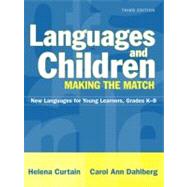
| Acknowledgements | |
| Preface | |
| Introduction | |
| Key Concepts for Success: Elementary and Middle School Foreign Languages | |
| Standards for Foreign Language Learning in the 21st Century: Overview | |
| Focus on the Learner | |
| Characteristics of Young Learners | |
| Second Language Acquisition | |
| Cognitive Characteristics of the Learner | |
| Developmental Characteristics of the Learner | |
| Creating an Environment for Communication | |
| Meaningfulness as a Priority for Classroom Activity | |
| When Is ldquo;Communicativerdquo; Not Communicative? | |
| Developing Contexts for Tasks and Activities | |
| Teaching in the Target Language: Context for Communication | |
| Person-to-Person Communication: The Interpersonal Standard (1.1) | |
| Vocabulary | |
| Total Physical Response: TPR | |
| The Natural Approach | |
| TPR Storytelling: TPRS | |
| Functional Chunks | |
| Direct Teaching of Speaking | |
| Writing and the Interpersonal Mode | |
| One-Way Communication: Interpretive and Presentational Modes (1.2, 1.3) | |
| Communication in the Interpretive Mode | |
| Listening | |
| Reading | |
| Communication in the Presentational Mode | |
| Speaking | |
| Writing | |
| Literacy Issues | |
| Connection Between Oral and Written Language | |
| Building Blocks of Second Language Literacy | |
| Building Literacy in the Second Language Classroom | |
| Interpersonal Communication: Partners and Small Groups | |
| Cooperative Structures, Cooperative Learning, and Interactive Language Tasks | |
| Managing Small Group and Partner Activities | |
| Sample Cooperative Group Activities for Beginning Language Learners | |
| Sample Partner Activities for Beginning Language Learners | |
| Planning for Success in the Early Language Classroom | |
| Integrated Thematic Planning for Curriculum, Unit, and Lesson Design | |
| Why Thematic Instruction for the Early Language Curriculum | |
| Thematic Planning for K-8 Classrooms | |
| Planning the Daily Lesson | |
| Planning for Immersion, Bilingual, and Content-Based Instruction | |
| Sample Partner Activities for Beginning Language Learners | |
| Using Assessment to Help Students and Programs Grow. ds | |
| The Theory and Research Base for Phonics and Spelling Instruction | |
| Prior Knowledge and Meaning Vocabulary | |
| Activate Prior Knowledge When Presenting New Ideas | |
| Introduce Vocabulary in Meaningful Settings | |
| Select Vocabulary for Special Attention | |
| Represent Word Meanings Multiple Ways | |
| Accomodations and Adaptations for Vocabulary | |
| Develop Independence in Vocabulary Learning | |
| Accomodations and Adaptations for Morphemic Analysis | |
| Promote Vocabulary in All Subjects | |
| The Theory and Research Base For Prior Knowledge Activation and Vocabulary Instruction | |
| Reading and Responding to Literature for Children | |
| Welcome the Diverse World of Literature | |
| Use Literature to Promote Thinking and Feeling | |
| Accommodations and Adaptations-Just the Right Book | |
| Link Reading and Writing Instruction with Children''s Books | |
| Schedule Daily Self-Selected Reading | |
| Celebrate Book Response Projects | |
| Enrich All Subjects with Literature | |
| The Theory and Research Base | |
| For Reading and Responding to Literature for Children | |
| Comprehension | |
| Reading Comprehension Requires Word Identification, Prior Knowledge, Strategies, and Engagement | |
| Comprehension Can Be Developed with All Kinds of Materials in all Subjects | |
| Comprehension Strategy Lessons Engage Students Before, During, and After Reading | |
| Use a Variety of Before and After Reading Activities to Teach Comprehension Strategies | |
| Accommodations and Adaptations That Develop Comprehension | |
| Use a Variety of Reading Formats to Make Guided Reading Multilevel | |
| The Theory and Research Base for Comprehension | |
| Writing | |
| Self-Selected Writing Promotes Engagement | |
| Accommodations and Adaptations That Develop Writing | |
| Table of Contents provided by Publisher. All Rights Reserved. |
The New copy of this book will include any supplemental materials advertised. Please check the title of the book to determine if it should include any access cards, study guides, lab manuals, CDs, etc.
The Used, Rental and eBook copies of this book are not guaranteed to include any supplemental materials. Typically, only the book itself is included. This is true even if the title states it includes any access cards, study guides, lab manuals, CDs, etc.